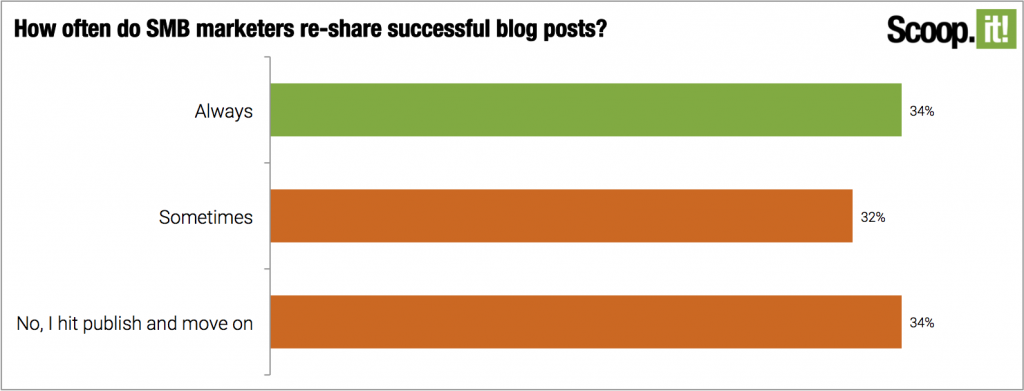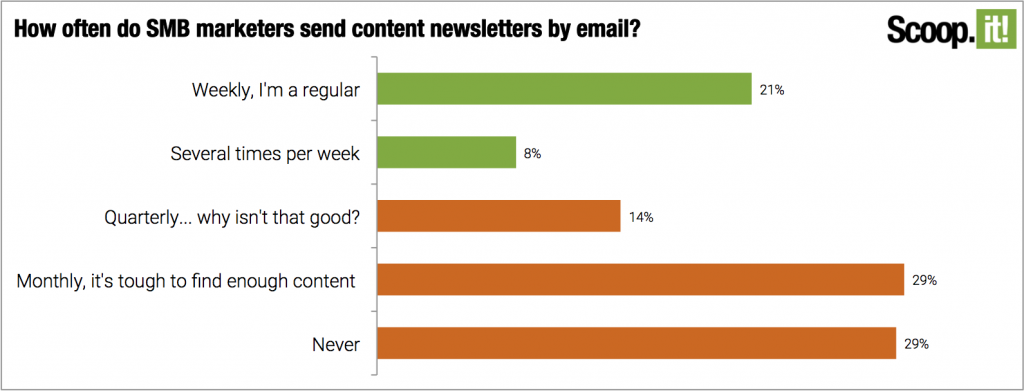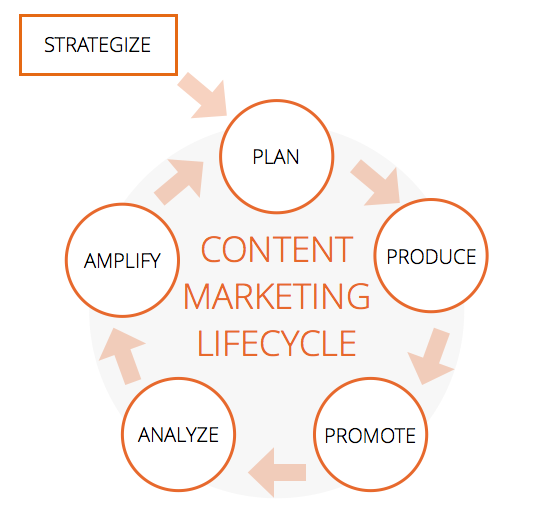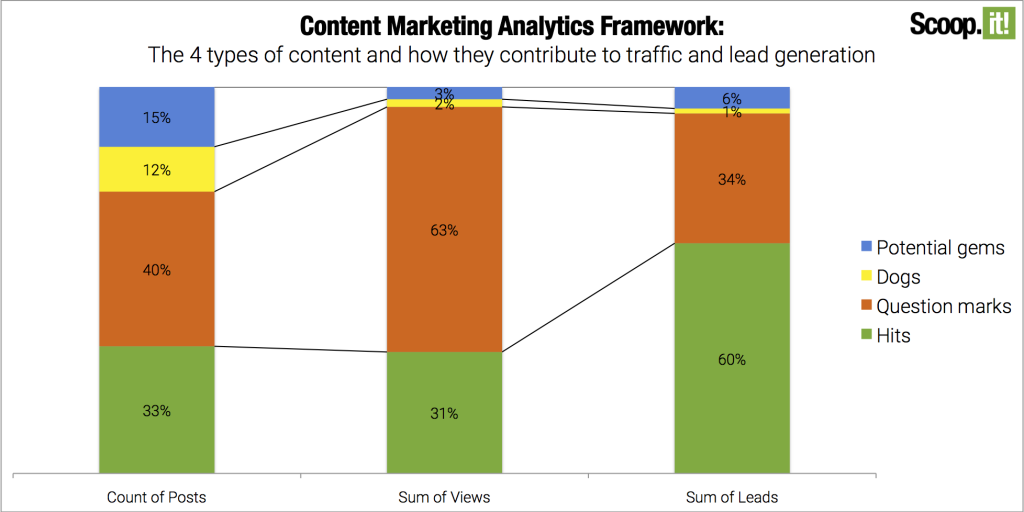It takes a lot of work to create a piece of high-quality content. By the time we’ve hit the “Publish” button, most of us let go a sigh of relief. “Glad that’s done,” we think.
But is it really done? As many of you know, when we hit publish, the work isn’t nearly done. In some ways, it’s just beginning.
Simply sharing your new piece of content once or twice is a good start, of course. Most everybody knows that. And most everybody does it. But it’s not enough. If you want your content to reach people, a couple of social media shares isn’t going to cut it. The average lifespan of a tweet is only about 24 minutes, after all. Facebook organic reach is in the single digits.
A lot of you already know this. Hopefully, you’re among the 34% of marketers who “always” re-share blog posts. Or at least you’re among the 32% of do it often.

Maybe you send your new content to your email subscribers, too. In our study of 1,000+ content marketers, we found that about 29% of marketers do this regularly enough.

That’s a good start, but again – you’ve only just begun. Sharing our content is only the first step of a larger series of steps that should be happening after publication.
Here’s what those steps should be
- Share
- Promote
- Analyze
- Amplify
- Strategize/Plan
It looks something like this:

A deeper look into the content marketing lifecycle
Let’s expand on what happens at each step.
Share
This includes the first shares we mentioned earlier. One way to think of sharing (as opposed to promotion, the next step) is that you’re reaching out to your existing following. This includes your social media followers, your email list, and even your co-workers. They’re all part of your existing contacts.
Promote
Now we’re reaching out to people who aren’t necessarily in our circles. You might do some influencer outreach, to let people who have been interested in this kind of content before know about your new content. Maybe you’ll answer some questions related to your new piece of content on Quora or LinkedIn or a few Facebook groups. Then you’ll add a link to your content in those answers to let people know where they can learn more.
Analyze
By now, you’ve gotten some reasonable exposure for your new piece of content. It’s time to take a look at the results you’ve gotten so far and see if all the work has been worthwhile.
Shares are great of course. Many of us measure the initial success of our content based on share counts. But for most content marketers, what they really want is leads. And ideally, we’ll want to be able to measure the quality of those leads.
For this, you’ll need some tracking software. Google Analytics is a start, but it can be unwieldy if you’re trying to manage a lot of different content pieces. Our own Content Director software is specifically built for this kind of analysis. It saves a lot of time on running reports.
Whatever you use to analyze the performance of your content, one thing is sure: Not everything you’ve published is going to be a winner. It’s likely your content pieces will break out into roughly four groups:
- Hits (pieces that were unquestionable wins)
- Potential gems (pieces that did well, but could use some help)
- Question marks (pieces with mediocre performance)
- Dogs (stuff that just did not interest your audience at all)
Here’s how our content broke out into those categories when we did an analysis of it earlier this year:

Amplify
Now that you know which pieces of content really got results, it’s time to amplify the reach of the winners. This includes advertising them on social media, content sites and maybe with some pay per click spending.
It also means repurposing them into different formats. That way, they’ll reach people who might prefer to watch the content as a video, or read it as an ebook, or see it as an infographic.
You should also schedule them to be reshared to your social media followers on a regular basis. Don’t worry – people won’t complain you’re sharing the same thing over and over. Reach is so slim, they may never notice. And sharing those top-performing posts over and over means major improvements to your lead generation and traffic goals. It’s not a reach to say you could be getting 10% more results simply by putting these top-performers into a regular re-sharing rotation.
There are many other ways to amplify your content. We’ve written about them here, here and here.
Plan
We’re coming into the home stretch here. You’ve published, shared with your inner circle, and promoted your content to a larger circle. Then you analyzed it and gave the top-performing pieces another boost with amplification.
Now you want to plan what you’ll do next. Based on how all your content has performed recently, ask yourself these questions:
- What types of new content should you create next?
- What topics does your audience seem most interested in, that would also move them toward becoming customers (or better customers)?
- Have your business goals changed?
- Do you have a new market to make content for? A new buyer persona?
- Is there a new content format (video, perhaps) that you really want to invest in?
- Are there any new strategies you’d like to test?
- Are there any tasks in your content marketing that you’d like to stop doing?
Now’s the time to decide about all that, then plan how you’ll execute it. Right down to filling out your editorial calendar.
Content marketing is an ongoing process
Remember this graphic? It’s where we started out, and where we’ve just ended up.

After you’ve finished that most recent stage of planning, you’re back to producing more content. When you eventually click “publish” again, you’ll move through all the phases we’ve described.
This should all be happening with every piece of content you publish. Everything from Facebook posts to blog posts, webinars and ebooks to infographics and videos. You may have to manage different metrics for different pieces of content, and for different content formats.
To make it all even more complicated, it’s quite possible some of your content pieces will do great for one of your business goals – like lead generation. But they’ll flop when it comes to, say, inbound links. So you’ll have to slice and dice your reports again to find which piece deliver on inbound links. And you’ll need to make sure those valuable pieces don’t get lost in the shuffle.
Does it feel like a lot? It is. But remember: We’re not managing this with index cards. And hopefully, not even with a tricked-out spreadsheet. There is good content marketing software available. It’s been built from the ground up to manage all these processes.
Conclusion
It’s time we content marketers moved out of the mindset that content marketing is primarily publishing content. That’s part of our jobs, but it’s only one element. We need to think like marketers, and to think of our content marketing as a continuous process. This is exactly how to get better results, and how to break away from the “random acts of content” that defined early content marketing.
Back to you
What do you do after you click the “publish” button? Share your thoughts in the comments – or let us know about any big wins you’ve had lately with content promotion or analysis.
If you want to get 30 effective techniques to master content marketing along with valuable insights from 10+ influencers like Mark Schaefer, Rebecca Lieb, Lee Odden, Jason Miller or Ian Cleary, download our free eBook now!



Hitting publish button is an easy thing, but what happens next is definitely depend upon how to plan, promote, share, analyze and amplify.
Thank you for sharing this detailed article.
I like the idea of thinking like marketers and plan strategically your blogging journey.